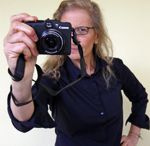If you came here expecting a discussion of the corn used to make fine Kentucky whisky, move along. This is about photography.
A recent Miami Herald article about a West Palm Beach museum includes a shot of photographer  Annie Leibovitz aiming a point-and-shoot camera at the reader. Kind of reminds us that a great photographer can take a magnificent picture with pretty much any box with a hole in one end.
Annie Leibovitz aiming a point-and-shoot camera at the reader. Kind of reminds us that a great photographer can take a magnificent picture with pretty much any box with a hole in one end.
But she still has to print it. That’s where I run into difficulty.
If Ms. Leibovitz printed her photos to fit in a standard frame with a pre-cut mat, (most) arts and crafts stores carry frames and mats with openings in only these sizes:
| Frame Size | Mat Opening | Image Size | Aspect Ratio |
| 5″ x 7″ | 3.5″ x 5.5″ | 4″ x 6″ | 1.5 |
| 8″ x 10″ | 4.5″ x 6.5″ | 5″ x 7″ | 1.4 |
| 11″ x 14″ | 7.5″ x 9.5″ | 8″ x 10″ | 1.25 (about 5:4) |
| 16″ x 20″ | 10.5″ x 13.5″ | 11″ x 14″ | 1.27 |
| 20″ x 24″ | 15.5″ x 19.5″ | 16″ x 20″ | 1.25 |
| 24″ x 36″ | 19.5″ x 29.5″ | 20″ x 30″ | 1.5 (exactly 3:2) |
| 30″ x 40″ | 21.5″ x 31.5″ | 22″ x 32″ | 1.45 |
(Frame and mat openings vary from manufacturer to manufacturer.)
Most digital point & shoot cameras had an aspect ratio of 1.33 (4:3), the same as analog television or early movies. However, a 35 mm picture’s aspect ratio is 1.5 (3:2). This means that the long side is 1.5 times as long as the short side. Several digital cameras take photos in either ratio, and nearly all digital SLRs take pictures in a 3:2 ratio, as most can use lenses designed for 35 mm film.
The Advanced Photo System (APS) film, a now-discontinued film format for still photography, has about a 7:4 aspect ratio, coincidentally almost perfect for HDTV except for how lousy an enlargement APS film yields. In 2005 Panasonic launched the first consumer digital camera with the very similar aspect ratio of 16:9; that matches HDTV and is the same as Ms. Leibovitz’ Canon G-15. 16:9 is the same as 1.77 which you might notice matches none of the standards in the table above.
Confused yet? Me, too.
I’ve taken thousands of photos with either a Kodak or Minolta digital. The Kodak has a 1/1.76″ (7.3 x 5.5 mm) CCD sensor, the Minolta a slightly larger 2/3″ (8.8 x 6.6 mm) sensor. Both are on the sweet spot 1.33 aspect ratio which means I had to throw away part of the picture for all their 8 x 10″ and 11 x 14″ prints in the gallery.
That’s one reason I changed to a full format digital for most shoots.
All these different aspect ratios is why everyone has cropping issues when printing photos. An aspect ratio of 4:3 translates to a print size of 4.5″ x 6.0″. This loses half an inch when printing on the “standard” of 4″ x 6″ with its aspect ratio of 3:2. Similar cropping occurs when printing on other sizes, i.e., 5″ x 7″, 8″ x 10″, or 11″ x 14″. In fact, the only two “standard” print sizes that capture all of the frame of a full frame digital or its 35mm uncle are 4″ x 6″ and 24″ x 30″.
There’s not much market for 4″ x 6″ or 24″ x 30″.
On the other hand, there’s a lot more market for 16″ x 20″ or 24 x 30″ than for a post card size print and I couldn’t reliably enlarge my early work to those sizes.
I want to compose in the viewfinder so I want to print what I saw. I’m homing in on 10″ x 15″ and 14″ x 21″ as the “usual” enlargements in my own gallery. The first is perfectly sized for the standard 16″ x 20″ mat; the latter for a 20″ x 28″ which is fairly large. Now all I need is a processor who can print them. And a mat cutter ditto.
Of course, every photographer has great photos in some odd-ball format, so I’ll print that palm tree with the sap bucket at 10:1 and frame it vertically. I’m working on an interesting 3:1 panorama that I will probably print on canvas and display as a loooooooooooooooog horizontal triptych.
I hope you’ll buy them anyway.


Photography is fun.
I used to have a vintage photo of four, young, shirtless boys of grade school age holding back a Piper Cub as it revved its engine and whirled its propellor for take off. I was one of the waifs in the picture, and the detail was so sharp you could see a festering carbuncle on my left shoulder. The photo was taken with a standard, dime store point and click camera using 127 roll film.
In this day and time, Liebovitz could sell such a photo to a nostalgia-starved public for thousands of dollars.
Isn’t this interesting?
— George
That’s a pretty nice film format for amateurs like the original Brownie users (I think my later Brownie was a 127, too). After all, the “Baby” Rolleiflex, a Yashica TLR, and the Komaflex-S SLR had decent lenses and the Super Slides — 127 transparencies — were larger and more saturated than the 35 mm Verichrome or Plus X slides I grew up with. I sure miss Kodachrome, though.
Ms. Leibovitz’ G15 is impressive with a 12.1 Megapixel CMOS sensor and a decent enough zoom of about 6-30mm (35mm film equivalent is 28-140mm) but its resolution wouldn’t hold a candle to 127 color slide film.